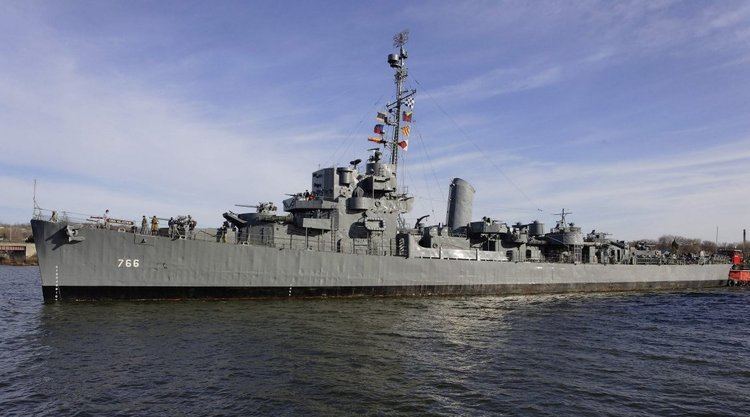 | ||
Operators United States Navy Royal Navy Republic of China Navy Free French Naval Forces French Navy Hellenic Navy Marina Militare Japan Maritime Self-Defense Force Republic of Korea Navy Philippine Navy Portuguese Navy Royal Netherlands Navy Royal Thai Navy National Navy of Uruguay Subclasses Evarts (GMT) classBuckley (TE) classCannon (DET) classEdsall (FMR) classRudderow (TEV) classJohn C. Butler (WGT) classDealey classClaud Jones class Similar Cruiser, Submarine, Battleship | ||
Wwii destroyer escort anti submarine warfare film 24712
Destroyer escort (DE) was the United States Navy mid-20th century classification for a 20-knot (23 mph) warship designed with endurance to escort mid-ocean convoys of merchant marine ships. Kaibōkan were designed for a similar role in the Imperial Japanese Navy. The Royal Navy and Commonwealth forces identified such warships as frigates, and that classification was widely accepted when the United States redesignated destroyer escorts as frigates (FF) in 1975. Destroyer escorts, frigates and kaibōkan were mass-produced for World War II as a less expensive anti-submarine warfare alternative to fleet destroyers.
Contents
- Wwii destroyer escort anti submarine warfare film 24712
- U s navy european cruise 1956 naval reserve destroyer escort training 89994
- General description
- Origins
- Post World War II US ship reclassification
- Vietnam War
- Captain class frigates of the Royal Navy
- Free French
- List of Free French destroyer escorts
- Mutual Defense Assistance Program Post WWII
- Republic of China Navy Taiwan
- French Navy
- Hellenic Navy
- Italian Navy
- Japanese Maritime Self Defense Force
- Philippine Navy
- Portuguese Navy
- Republic of Korea Navy
- Royal Navy
- Royal Netherlands Navy
- Royal Thai Navy
- National Navy of Uruguay
- Comparison with contemporary frigates
- Surviving destroyer escorts
- References
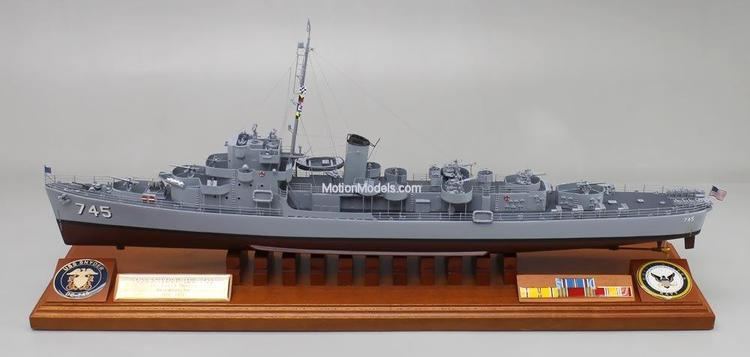
Post-war destroyer escorts and frigates were larger than those produced during wartime, with increased anti-aircraft capability, but remained smaller and slower than post-war destroyers. As Cold War destroyer escorts became as large as wartime destroyers, the United States Navy converted some of their World War II destroyers to escort destroyers (DDE).
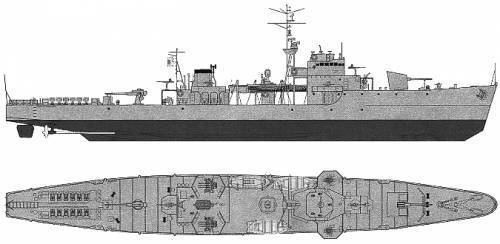
U s navy european cruise 1956 naval reserve destroyer escort training 89994
General description
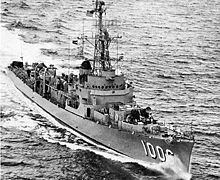
Full-size destroyers must be able to steam as fast or faster than the fast capital ships such as fleet carriers and cruisers. This typically requires a speed of 25–35 knots (46–65 km/h) (dependent upon the era and navy). They must carry torpedoes and a smaller caliber of cannon to use against enemy ships, as well as anti-submarine detection equipment and weapons.

A destroyer escort needed only to be able to maneuver relative to a slow convoy (which in World War II would travel at 10 to 12 knots (19 to 22 km/h)), and be able to defend against aircraft and detect, pursue and attack submarines. These lower requirements greatly reduce the size, cost, and crew required for the destroyer escort. Destroyer escorts were optimized for anti-submarine warfare, having a tighter turning radius and more specialized armament (such as the forward-firing Hedgehog mortar) than fleet destroyers. Their much slower speed was not a liability in this context, since sonar was useless at speeds over 20 knots (37 km/h). Destroyer escorts were also considerably more sea-kindly than corvettes.
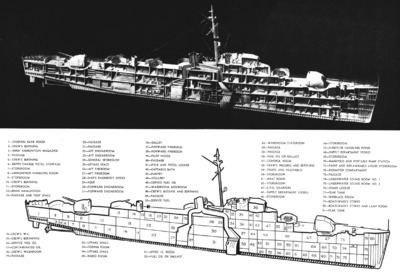
As an alternative to steam turbine propulsion found in full size destroyers and larger warships, many US destroyer escorts of the World War II period had diesel-electric or turbo-electric drive, in which the engine rooms functioned as power stations supplying current to electric motors sited close to the propellers. Electric drive was selected because it does not need gearboxes (which were heavily in demand for the fast fleet destroyers) to adjust engine speed to the much lower optimum speed for the propellers. The current from the engine room can be used equally well for other purposes, and post-World War II many destroyer escorts were recycled as floating power stations for coastal cities in Latin America under programs funded by the World Bank.
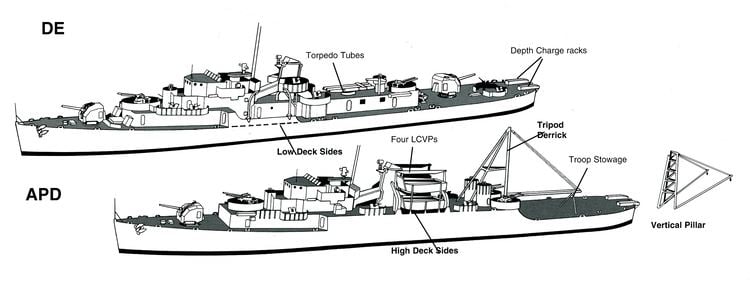
Destroyer escorts were also useful for coastal anti-submarine and radar picket ship duty. During World War II, seven destroyer escorts (DEs) were converted to radar picket destroyer escorts (DERs), supplementing radar picket destroyers. Although these were relegated to secondary roles after the war, in the mid-1950s twelve more DEs were converted to DERs, serving as such until 1960-1965. Their mission was to extend the Distant Early Warning line on both coasts, in conjunction with sixteen Guardian-class radar picket ships, which were converted Liberty ships.
In World War II, some 95 destroyer escorts were converted by the US to high-speed transports (APDs). This involved adding an extra deck which allowed space for about 10 officers and 150 men. Two large davits were also installed, one on either side of the ship, from which landing craft (LCVP) could be launched.
Origins
The Lend-lease Act was passed into law in the United States in March 1941 enabling the United Kingdom to procure merchant ships, warships, munitions and other materiel from the US, in order to help with the war effort. This enabled the UK to commission the US to design, build and supply an escort vessel that was suitable for anti-submarine warfare in deep open ocean situations, which they did in June 1941. Captain E.L. Cochrane of the American Bureau of Shipping came up with a design which was known as the British destroyer escort (BDE). The BDE designation was retained by the first six destroyer escorts transferred to the United Kingdom (BDE 1, 2, 3, 4, 12 and 46); of the initial order of 50 these were the only ones the Royal Navy received, the rest being reclassified as destroyer escort on 25 January 1943 and taken over by the United States Navy.
When the United States entered the war, and found they also required an anti-submarine warfare ship and that the destroyer escort fitted their needs perfectly, a system of rationing was put in place whereby out of every five destroyer escorts completed, four would be allocated to the U.S. Navy and one to the Royal Navy.
Post-World-War-II U.S. ship reclassification
After World War II United States Navy destroyer escorts were referred to as ocean escorts, but retained the hull classification symbol DE. However other navies, most notably those of NATO countries and the USSR, followed different naming conventions for this type of ship which resulted in some confusion. In order to remedy this problem the 1975 ship reclassification reclassified ocean escorts (and by extension, destroyer escorts) as frigates (FF). This brought the USN's nomenclature more in line with NATO, and made it easier to compare ship types with the Soviet Union (see cruiser Gap). As of 2006 there are no plans for future frigates for the US Navy. USS Zumwalt and the littoral combat ship (LCS) are the main ship types planned in this area. One major problem with ship classification is whether to base it on a ship's role (such as escort or air defense), or on its size (such as displacement). One example of this ambiguity are the Ticonderoga-class air-defense ships, which are classified as cruisers even though they use the same hull as the Spruance-class destroyers.
Vietnam War
During the Vietnam War, the Republic of Vietnam Navy received two Edsall-class destroyer escorts from the United States.
Captain-class frigates of the Royal Navy
The Captain class was a designation given to 78 frigates of the Royal Navy, constructed in the United States, launched in 1942–1943 and delivered to the United Kingdom under the provisions of the Lend-Lease agreement (under which the United States supplied the United Kingdom and other Allied nations with materiel between 1941 and 1945), they were drawn from two sub-classes of the destroyer escort (originally British destroyer escort) classification: 32 from the Evarts sub-class and 46 from the Buckley sub-class. Upon reaching the UK the ships were substantially modified by the Royal Navy including removal of torpedo tubes, making them distinct from the US Navy destroyer escort ships.
Captain-class frigates acted in the roles of convoy escorts, anti-submarine warfare vessels, coastal forces control frigates and headquarters ships for the Normandy landings. During the course of World War II this class participated in the sinking of at least 34 German submarines and a number of other hostile craft with 15 of the 78 Captain-class frigates being either sunk or written-off as a constructive total loss.
In the post-war period, all of the surviving Captain-class frigates except one (HMS Hotham) were returned to the US Navy before the end of 1947 in order to reduce the amount payable under the provisions of the Lend-Lease agreement; the last Captain-class frigate was returned to United States custody in March 1956.
Free French
Six Cannon-class destroyer escorts were built for the Free French Navy. Although initially transferred under the Lend-lease Act these ships were permanently transferred under the Mutual Defense Assistance Program.
List of Free French destroyer escorts
Mutual Defense Assistance Program - Post WWII
Under the Mutual Defense Assistance Program (MDAP) the Destroyer Escorts leased to the Free French were permanently transferred to the French Navy. In addition the following navies also acquired Destroyer Escorts:
Republic of China Navy (Taiwan)
DE-47, DE-6French Navy
DE-1007, DE-1008, DE-1009, DE-1010, DE-1011, DE-1012, DE-1013, DE-1016, DE-1017, DE-1018, DE1019Hellenic Navy
DE-173, DE-766, DE-768, DE-193Italian Navy
DE-1020, DE-1031Japanese Maritime Self-Defense Force
DE-168, DE-169Philippine Navy
DE-168, DE-169, DE-170, DE-770, DE-771, DE-251, DE-637Portuguese Navy
DE-1032, DE-1039, DE-1042, DE-1046Republic of Korea Navy
DE-770, DE-771Royal Navy
DE-574
Royal Netherlands Navy
USS Burrows (DE-105), USS Rinehart (DE-196), USS Gustafson (DE-182), USS O'Neill (DE-188), USS Eisner (DE-192), USS Stern (DE-187)Royal Thai Navy
DE-746National Navy of Uruguay
DE-166, DE-189,Comparison with contemporary frigates
The table below compares United States destroyer escorts with other destroyer escorts and frigates designed for similar missions.
Surviving destroyer escorts
Four destroyer escorts are preserved as museum ships, while others remain in active service.
